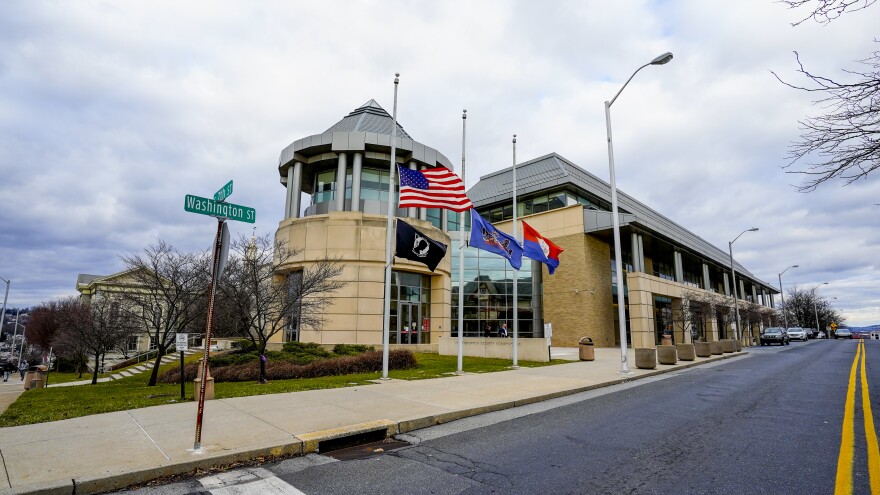EASTON, Pa. — An upcoming plan for the next 25 years of the Lehigh Valley’s transportation spending has drawn ire from Northampton County officials for giving more funding to projects in Lehigh County than to those in Northampton.
- The newly updated Lehigh Valley Long-Range Transportation Plan allocates significantly less money to Northampton County than to Lehigh County, drawing the ire of county officials
- The plan will guide the next four years of transportation construction projects and sketch out the next 25 years of transportation spending
- Planned projects include improvements to Route 22 and the Airport Road corridor. The plan identifies $2.27 billion in projects over the next 25 years without funding
The Long-Range Transportation Study, redone by the Lehigh Valley Transportation Study every four years, is how federal transportation funding is prioritized and doled out in the Lehigh Valley.
The plan is divided into three time periods: short-term projects begin in the next four years, medium-term projects from 2027 to 2034, and long-term plans break ground from 2035 to 2049.
The short-term plan is particularly impactful, as it is developed into a Transportation Improvement Program. The long-range plan is just that — a plan — while the TIP represents actual spending and construction over the next four years.
Northampton County Executive Lamont McClure said long-range projects “may never happen.”
Of the more than $1.38 billion allocated for the short term, projects solely in Lehigh County got 2.7 times as much transportation funding as those in Northampton County.
Another pot of funds, about a quarter of the short-term funding, covers transit and other projects that cross county lines.
In the long-term plan, the difference between Lehigh and Northampton county projects shrinks, but remains: Lehigh projects get $725 million, about 1.45 times as much as Northampton’s $500 million allocation.
Cross-county infrastructure and transit projects account for more than half of long-term funds.
LVTS also identified some $2.27 billion worth of projects without funding over the 25-year planning period.
'Still way, way, way behind'
At a Northampton County Council committee meeting last week, Northampton County Executive Lamont McClure said the allocation of transportation money has always unfairly favored Lehigh County, and will for at least “another generation.”
“We have made some incremental progress — some incremental progress — but ultimately, you will see that we are still way, way, way behind, and will remain way, way behind into the 2040s,” McClure said.
“There was a real opportunity to sort of change the dynamic here. We didn’t.”
County Council members were more critical.
“I'm not accusing anybody of trying to shortchange Northampton County," Commissioner Kevin Lott said. "But the fact is, we are shortchanged.”
Commissioner Kerry Myers said, “We’re going to be dead by the time we get equality with this money. I’m 69. I will not see equality in this budget.”
Myers and other members also criticized the concentration of projects in the more populous parts of the valley, compared with regions such as the Slate Belt.
Commissioner Tara Zrinski defended the funding gap, citing the difference in communities designated as disadvantaged “Justice 40 communities” between the two counties.
She said that equality — that is, giving the two counties the same dollar amount in project funding — is not the same as equity, or distributing funding fairly.
How projects are funded
To prioritize the submitted projects, LVTS devised a scoring system for proposals, in part using the rules and stipulations that come with federal money.
In all, the scores factor in 120 different datasets; it does not consider a project's location.
If ultimately approved, the plan includes $595 million for improvements to Route 22, with an eye toward widening.
Also, $52 million would be earmarked for improvements to the Airport Road corridor, and additional money would go toward rebuilding interchanges between I-78 and Route 33 and between Route 22 and Route 191.
Lehigh Valley Planning Commission Executive Director Becky Bradley said every project proposed — 618 in all — was included in the plan.
If more money becomes available down the road, projects already included in the mid- and long-range plans can move ahead.
The LVTS Coordinating Committee will vote on adopting the Long-Range Plan in October.
'You're not going to wait 30 years'
Bradley said federal restrictions, often coming from Congress, limit how LVTS can allocate funding.
As a result, the body has relatively few options to even out the gap between Northampton and Lehigh counties.
“No, you’re not going to wait 30 years” for more equal funding between the counties, she told County Council. “It's already moving that direction, and I think that's the important component of it.”Lehigh Valley Planning Commission Executive Director Becky Bradley
For example, the body is required by law to prioritize roads with the most traffic, and projects that have the greatest impact on measures such as congestion and traffic fatalities.
Additionally, new Biden Administration rules require at least 40% of the funded projects to fall within census tracts designated as disadvantaged “Justice 40" communities.
Lehigh County has more of those communities than does Northampton. Lehigh also has more than twice as many people living in its "Justice 40"-designated census tracts.
Ultimately, the U.S. and Pennsylvania transportation departments get the final say on where funds end up.
In addition to structural factors favoring Lehigh County, that county's residents and municipalities simply submitted more projects for consideration.
As a result, while Lehigh County was allocated a higher dollar amount, Northampton County saw a greater percentage of its projects funded.
McClure said he had a few “drastic” ideas to shift the balance of funding in Northampton County’s favor, but they would probably harm the valley as a whole.
He did not share any specific recommendations, aside from pressuring state and federal legislators for more funding.
Still, despite the plan baking in a significant gap between the counties through 2049, Bradley said more equal funding is coming.
“No, you’re not going to wait 30 years” for more equal funding between the counties, she told County Council. “It's already moving that direction, and I think that's the important component of it.”
She also emphasized that the plan has been responsive to McClure’s input, describing work between McClure and the LVTS to find projects that could be moved from long-range into mid-range, or unfunded projects that could be allocated money.
“LVTS met in that fourth workshop and accommodated every one of those requests that we could within the guidelines. And so that's how you work on it, as you think through it, and you work through it together.”


